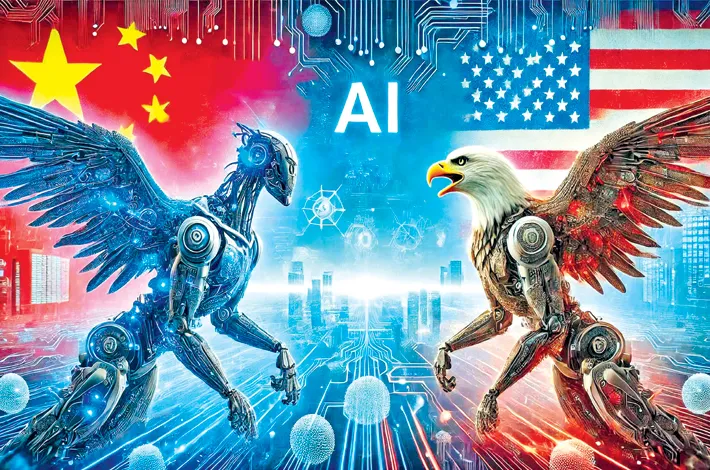Stargate AI: $500 billion bet by US
12-11-2025 12:00:00 AM

Traditionally, China used to provide tax exemptions, and research related incentives to its manufacturing industry. But having discovered the reasons and benefits of technology leadership of US, China focused on fiscal incentives to technology sector and of late aggressively to AI
It is a $500 billion bet (Rs. 44 lakh crs), biggest in the world and particularly on a technology project with shortest execution period. As United States and China are visibly in a trade war and secretly in a technology war, the backdrop is interesting, and the evolving developments hold suspense.US economy started experiencing a decline in the productivity and price competitiveness in its manufacturing sector towards the end of 1980s. The investments in internet and information technology helped US in resuming its economic growth.
Between 1990 and 2000, US experienced accelerated economic activity due to its technology leadership. Gradually other countries also embraced technology. This reduced the technology gap between US and many other countries although US maintained its leadership. By then, US created millions of jobs and attracted global talent at relatively lower compensations. Until 1990, US and Europe had almost same economic sizes. But over next 30 years US economy became 50 percent bigger than Europe due to its pioneering investments in internet and related technology.
Traditionally, China used to provide tax exemptions, and research related incentives to its manufacturing industry. But having discovered the reasons and benefits of technology leadership of US, China focused on fiscal incentives to technology sector and of late aggressively to AI. In year 2010, US tech market size was about $200 billion while that of China was $100 billion. But by year 2020 the tech market size of China grew 4 times against 2 times in US. During 2020 to 2025, tech market of China grew 50% while that of US grew only 25%.
The technologies such as machine learning, big data analytics, and robotic process automation appeared promising between 2017 to 2020 but soon lost dominance. Gradually, those technologies become subparts of evolving technologies and mostly of AI.US has been the world leader in advanced semiconductors and servers. In software integration with hardware, US had distant leadership. However, in the recent past, China gained dominance in electronics, AI chip design and manufacturing.
China is in the process of improving its software competencies while retaining its leadership in hardware manufacturing and more particularly AI enabled devices. US pioneered in AI but is facing increased competition from China and probably India as well. US realized the need to increase policy support to new technologies to avoid losing global leadership and the result was Stargate AI.Stargate AI was launched in January 2025 as a joint venture with $500 billion outlay and was incorporated in Delaware. The shareholdings are 40% each by OpenAI and Softbank Group, and the balance by Oracle and MGX.
The project kickstarted with $100 billion investment and is expected to complete fully by year 2029. Besides contribution of $100 billion from JV partners, the balance $400 will be mobilized from limited partners and debt.The project will create 10GW of data centres across multiple locations of which few in US and one in Abu Dhabi are under fast-track construction. Technology and critical data centres will be owned by Stargate AI and data centres will be created with local partnerships in US, UK, UAE, Norway, and Argentina and later in other countries as well. These local partners will invest on infrastructure having revenue arrangements with Stargate AI.
Softbank undertook financial responsibility, OpenAI undertook operational responsibility, and MGX (sovereign investment firm of UAE) supports finance and infrastructure. Other tie ups include Microsoft for cloud capacity, Nvidia for AI hardware, Arm for AI chip architecture, AMD for GPU supply, Crusoe Energy for data centres construction, and Cisco for network. The revenue avenues are technology user fee, AI computation as a service, cloud infra lease revenues, security contracts, and government services.
OpenAI and Oracle will earn revenues even during the construction phase which may pay them back their full investments with high returns. In the first year 2025 itself the project is earning revenue of $13 billion which is estimated to increase to $30 billion by year 2029. The recent statement by promoters expecting US government to invest in the project triggered wider debates. Analysts perceive funding and exponential policy support from US Government as preplanned. Many allege that the capacities are multi-fold meant to dominate geopolitics and kill the competition.
This project is also alleged as a strategy to retain dollar dominance like the petrodollar regime. If Stargate AI bet proves right, the economic, technology, and currency dominance of US continues for decades. The global integration with technology and currencies support US in this regard. The project benefits include 100,000 plus jobs in US, 1 million plus jobs in other countries, and investment up to $4 trillion globally. The benefitting sectors include pharma, healthcare, industries, energy, retail, and defence. Whether geopolitics or economics will influence the project depends on the intent of implementation.
- Dr. Kishore Nuthalapati, CFO of BEKEM Infra Projects Pvt Ltd, Hyderabad








